Wildfire Anxiety – Relaxation Tips
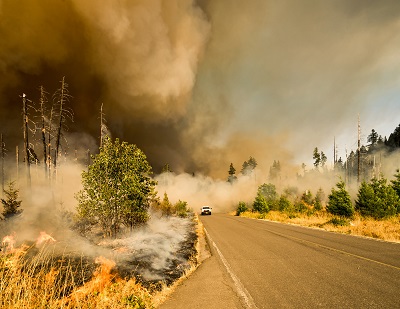 A muffled crack of thunder, followed by a flash of light that lit up the bedroom wall. Then another, louder CRACK! I had been lying in bed awake since 1AM, for three hours, my husband next to me, deep asleep. But now the wind was pushing violently against our windows, and I woke him up. I did not want to be experiencing this alone. We pulled the slider open and stepped out onto our bedroom deck, surveying western Sonoma County. Every thirty seconds another jagged bolt of lightning flashed somewhere on the horizon. In forty years of living in California we’d ever seen anything like this. There were the thunderstorms when we visited my mother-in-law in Florida. But here we were missing a crucial counterbalance to the lightning. Rain.
A muffled crack of thunder, followed by a flash of light that lit up the bedroom wall. Then another, louder CRACK! I had been lying in bed awake since 1AM, for three hours, my husband next to me, deep asleep. But now the wind was pushing violently against our windows, and I woke him up. I did not want to be experiencing this alone. We pulled the slider open and stepped out onto our bedroom deck, surveying western Sonoma County. Every thirty seconds another jagged bolt of lightning flashed somewhere on the horizon. In forty years of living in California we’d ever seen anything like this. There were the thunderstorms when we visited my mother-in-law in Florida. But here we were missing a crucial counterbalance to the lightning. Rain.
When the previous night news reports had warned about the possibility of dry lightning it hadn’t seem possible. But now it was more real than anyone would have predicted. Could every strike of lightning start a fire? In our dry, heavily forested landscape what would that mean? “This feels like the end of the world,” my husband said, “Let’s pack the car and get out of here while we can.”
Flashback
Almost three years earlier, in October 2017, we were awakened at 1 AM by a friend calling us to tell us we needed to get out of our home, now! The smell of smoke filled the room. The electricity was out. We frantically pulled on our clothes and within five minutes we were in our car, inching our way through the smoke towards safety. An hour later our home and everything we owned was gone.
Much of the same emotions I felt at that time were here again, telling me to flee. But I knew something was different this time. Now, in our rebuilt home, standing in virtually the same spot in our bedroom, I recognized danger. But unlike the threat of three years before, this threat was not imminent. “Yes, let’s pack the car,” I said, “But I’m not going anywhere just yet.”
Safety and Security Shattered
Over the next 72 hours, the lightning strikes started hundreds of fires in California, Oregon and Washington, some that are still burning. As I write this newsletter, a new fire is raging only five miles from my home. The smoke from these fires is fouling the air, affecting millions of people hundreds of miles away. This at the same time we are suffering the worst pandemic in a hundred years, an economy threatening to slip into a depression, and the worst political and social unrest in decades.
What Should We Do?
As a CBT therapist working with clients who think their world is falling apart, and as a human being who has similar thoughts myself, I know that our natural instinct is to take action. Whether it is fighting or taking flight, or even freezing in place, our first reaction to the threat of loss is usually emotional reaction. We’re hard-wired this way. This leads to behaviors, like my husband wanting to jump in the car and get away. The problem with taking action when we are upset, is that it is unlikely to be wise action. The storm that morning was passing over us, casting bolts of lightning in every direction. Some of them could start fires, but which ones we’d have no way of knowing. Imagine my husband and I driving around Northern California, each time there was a strike of lightning ahead, turning the car around and driving a different direction. Imagine hundreds of thousands of other cars doing the same thing.
With an imminent threat, like a smoke-filled bedroom, our emotions are well equipped to guide us. But most of the threats we face today, though real, are not imminent, and thus, require wise action. And to unlock our own innate wisdom, we need to be able to tolerate the fight-flight emotions telling us to Do something now!
The therapy I provide for my anxious clients is simply teaching them to relax and lean into fear. Unless it becomes clear that action is called for, just being, not doing, is how we free ourselves from the trap of chronic fight-flight reactions to our anxiety.
Emotion & Meditation
In a perfect storm of uncertainty that we are all living in today it is of some comfort to me to know that spiritual masters agree. Pema Chodron, a Buddhist nun, has written extensively on how to find peace amid crisis. She says we must stay with our broken heart, our fear, our anger and outrage, that only by sticking with uncertainty do we learn to relax in the middle of chaos. This is the essence of mindfulness meditation—to place our attention on the thoughts, feelings, and emotions that are disturbing us in the moment, without attachment, judgment, storytelling, or problem-solving.
Many of us are familiar with the exercise of watching our thoughts without attachment, but it is often more difficult for us to do the same with our feelings. To curb our urges to resist and/or control our negative emotions, we must learn to experience the sensation of emotions in a grounded way, dropping our awareness out of our heads and into our bodies. The simplest path is to use our breath to open, surrender, allowing our muscles to soften, making space for our emotions to metabolize. Only when we can relax amidst the chaos of our emotions, can we conceive what is wise action.
Wise Action
The morning of the lightning storm, we packed our car with emergency supplies, water, tent, sleeping bags, and food. But we didn’t drive off looking for a safe place. We went for a silent hike in a wooded area that had burned the year before. In the distance we could see the storm continuing, but we could also see new growth coming back and many of the old oaks had survived. Nature has a way of healing itself. We too have a natural ability to heal ourselves. And I believe, that collectively, we will be able to heal from the crisis that we face—from fires, from the pandemic, from the political polarization and social injustice, to whatever we face in the future. The first step is for each of us to move from a fight-flight reaction to wise action.
Meditation for Emotion
By opening up to painful emotions, we are learning to relax into discomfort itself. This meditation will help you to be here for yourself, no matter what you are feeling. You can listen to this meditation by clicking here.
This article first appeared on the website of the Anxiety and Depression Association of America.
How to Stay Mentally Healthy Under Apocalyptic Skies
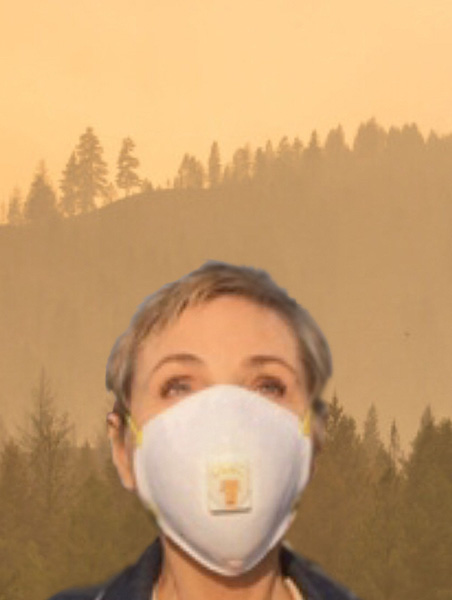
We are hearing a lot about how to stay physically healthy with our skies covered with dangerous levels of smoke in the air. Stay indoors as much as possible, Outside, wear a N95 rated face mask and avoid strenuous exercise. Set your car cooling and heating system to recirculate. But how do we take care of our mental health when we are faced with real danger?
HINT: Do not leave this job up to your monkey mind!
To the survival-oriented security guard residing in our unconscious, nothing less than 100% safety will do. Left unchecked, the monkey mind will continue to barrage us with negative emotion until the threat posed by air pollution is completely eliminated. In our highly emotional state we feel compelled to act.
We monitor news feeds about fire containment now.
We check to see what the air quality is now.
We research air purifiers, compare masks vs. respirators, and study long term health risks.
We worry about what the air may be doing to our health and the health of our loved ones.
We look at real estate outside of California.
The 90/10 Rule
If we leave ourselves unchecked, we will be spending 90% of our time attempting to eliminate the risk of breathing tainted air—allowing the monkey mind to run the show—and 10% of our time doing restful and restorative activities that foster mental health.
When under physical stress, we need to do just the opposite. That means spending 10% of our time taking reasonable precautions, and 90% of our time learning to relax in the face of danger and uncertainty. Here are three suggestions how to tame the monkey and manage that reversal.
1. Limit time on checking and researching. This might mean checking news feeds just once in the morning and once in the evening. If you are researching air purifiers, set the timer for 30 minutes and once it goes off, either make the decision then, or put off more research until tomorrow.
2. Notice when you are acting with the monkey mindset: I cannot rest or relax until I have eliminated the threat posed by air pollution. Remind yourself of the new “expansive” mindset you want to cultivate instead: I can take reasonable precautions that can limit risk, but it is just as important to learn to relax into uncertainty, which fosters resilience to whatever happens in life.
3. Listen to a welcoming anxiety practice I made specifically for this air quality crisis. Learning to welcome anxiety, rather than reacting to it, not only fosters a more peaceful state of mind, it calms down the nervous system, a key to emotional health.
My last suggestion is to try to have some fun. What restful or restorative activity can you do, given the restrictions of the situation? My daughter calls it taking a “smoky snow day”. Share your ideas and/or experience by posting a comment!
Welcoming Under Apocalyptic Skies
Dealing with Crisis – Still Feeling Dazed

The link below is for an op-ed article I wrote that was published in the Santa Rosa Press Democrat on December 3, 2017. Please share it far and wide, particularly with anyone you know who was touched by the fires, loves people touched by the fires, or is a compassionate helping professional who is caring for or treating someone who was touched by the fires.
http://www.pressdemocrat.com/opinion/closetohome/7711540-181/close-to-home-still-feeling
Dealing with Crisis – Community, Connection and Serendipity
by Jennifer Shannon, LMFT
The population of Santa Rosa is 175,000. While I love where I live and it has always felt like home, I can’t say that I’ve felt a strong sense of community. That has changed dramatically since the Tubbs fire that destroyed 3,000 homes, including mine, and caused the evacuation of thousands more.
Yesterday I got together with my friend Katherine for lunch in Healdsburg. She lives on Mark West Springs road, which was hit hard, and during the evacuation we texted back and forth about Mojo, our Jack Russell terrier that was missing and her horses and cats, which she had to leave behind. Although we were glad we had escaped with our lives, the possible loss of our beloved animals was agonizing. Fortunately, as it turned out, they all survived.
About 45 minutes into our lunch, sharing stories and tears, Katherine asked me how Mojo was found. “Mojo?” said our waitress who was refilling our glasses of water. “The little terrier lost in the fire? I’m the one who found him!”
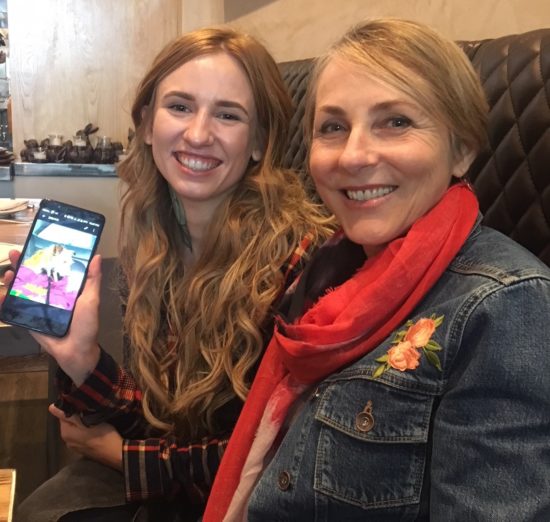
Danae shows me a picture of Mojo from the day she saved him.
My jaw dropped. This was the young woman who, along with her boyfriend, met us in a Raley’s Parking lot to deliver our dog. But I was in shock at the time, and hyper focused on Mojo, who sat shivering in the back seat of their car. I was grateful, but honestly did not remember them or their faces. Doug and I wanted to see them later, to thank them again, but were not sure how to get a hold of them.
Tears of gratefulness, surprise, and awe trickled down my face. We’d picked this restaurant, new to us, in a nearby town, and randomly been given this table with this waitress. Then Katherine asked about Mojo at the exact moment she came to refill our water glasses! When our waitress, who introduced herself as Danae, had a break she sat down with us and showed us picture on her phone of Mojo at the time of the rescue. Then she told us in detail how the rescue took place.
The day after the fire, Danae and her boyfriend, both dog owners themselves, happened to see Mojo running erratically through a chaotic scene of fire trucks, police and residents in the still smoldering Coffee Park area. He was obviously lost, and they ran after him. Danae said she’d never seen a dog run so fast, it didn’t look like his feet were touching the ground. They chased after him through the streets for nearly half an hour until finally, Mojo jumped into a swimming pool, filled with fire debris, logs and ash. When Danae saw him go under the water she instinctively jumped in after him. She was able to grab him and as she handed him up to her boyfriend, the dog, crazy with fear, bit him on the hand. Only after they read Mojo’s tag, and began calling him by his name was he able to calm down. He even began licking their hands. And then they called us.
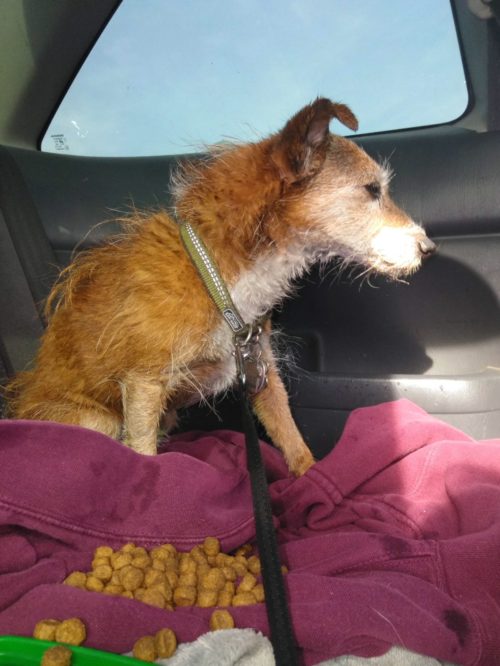
Mojo wet and tired in the backseat of Danae’s car after being rescued.
Later, as we were waiting for our check, Danae told us that a woman sitting at a nearby table overheard that I had lost my home and paid for our lunch. I went over to thank her, and I found out that she too lives in Santa Rosa, and that although it was touch and go, her house was saved. She said she is now renting out a small house on their property to a couple who had also lost their home in Fountaingrove. I asked who it was, and it turned out it was my neighbor from the condo next to ours!
That wonderful afternoon, with my friend, the woman who saved our dog, another woman who paid for our lunch and opened a home on her property to a neighbor who lost her home, I had a stronger sense of community and connection than I had ever had, not just in Santa Rosa, but in my life. This is something I am tremendously grateful for this Thanksgiving.
As a therapist and author who specializes in stress and anxiety, and has lost my home in the Santa Rosa fire, I am writing this blog to remind myself of the powerful tools I use in my practice with my clients. If It helps others to deal with their own challenges, nothing would please me more.
Dealing with Crisis – Home Sweet Home
by Jennifer Shannon, LMFT
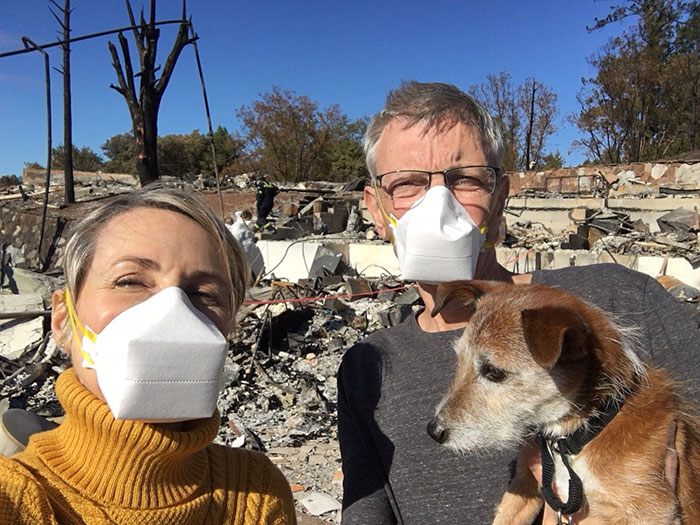
The remnants of our home. Me, Doug, and Mojo
Sunday evening, the night before the fire, Doug and I returned from a weekend away. When I walked into the house I said to Doug, “Home Sweet Home”. It felt good to be back. Ever since I was a child, home has been my favorite place on earth. I am an introvert, and so the solitude that I get from being at home recharges me. In addition to the solitude, my belongings gave me comfort. My bed and blankets, my couch, my soft carpet, my plants, and my cloths; the familiarity of my home was comforting. Knowing where everything was in the kitchen, a kinesthetic knowledge of the stairs, how my furniture was arranged, even in the dark I could navigate my home.
The fire destroyed all of that, so quickly, so thoroughly. While seeking shelter at my mother’s tiny studio at 3AM that morning, my mind was going to where would we stay? In my book, Don’t Feed the Monkey Mind, I talk about how all fear and anxiety comes down to 2 core fears. Number one is the loss of life, loved ones, health or food and shelter. I was already incredibly grateful that Doug and I were alive, but I did lose my shelter. I impatiently waited until a decent hour to text a friend of mine who I knew had a spare room, to ask if we could stay there. She texted back immediately saying “Of course”. Ahhhhh.
We stayed with my friend for a month. Her home is out in rural Occidental, and the quiet of nature soothed my disquieted soul. I was so grateful to have a warm bed to crawl into each night. But I did not have the solitude I was used to while living in someone else’s home. I did not have my things, and I did not have familiarity with where things were.
We started looking for a long-term rental. This has been one of the most stressful things I have had to do since the fire. The rental market in Sonoma county is very tight, and with 3,000 people losing their homes, I knew that it would be even tighter. My monkey mind was going wild, what if we don’t find something, what if we must settle for a place that I won’t ever feel comfortable in? So, I drew on my community. I asked everyone I know, from the ladies in the locker room at the gym to my friends and acquaintances to keep their eyes open. I was able to escape the cutthroat completion for housing that I feared. My community came through for me. An acquaintance from my Toastmasters Club offered her Airbnb for us to stay at while we rebuild our home.
Moving to a new place is pretty easy when you have nothing to move into it. The home is already furnished, so we don’t have to shop for all new household items. Now it is time to nest. I have the solitude back, which feels amazingly wonderful. I feel tentative with the things in the house, as I don’t own them, and I am getting used to the layout of the house and the land. This morning at dawn, I took a walk around the perimeter of the property, saw an owl hunting for food, the sun rising, the fog and the clouds. Nature, in all her glory has always been here for me, this I can return to over and over, no matter where I am.

The property around our new rental home.
As a therapist and author who specializes in stress and anxiety, and has lost my home in the Santa Rosa fire, I am writing this blog to remind myself of the powerful tools I use in my practice with my clients. If It helps others to deal with their own challenges, nothing would please me more.
Dealing with Crisis – Letting Go a Little
by Jennifer Shannon LMFT, with Doug Shannon

I started back to Toastmasters this week. It starts at 7am and I like to be on time, but I am staying temporarily with a friend way out in the country, and getting to town takes a long time. After packing up all the things I’d need for a long day at work, I ended up leaving 10 minutes later than planned. As I turned the ignition my mind started racing, grasping for a way to control the situation. How late will I be? What route is the fastest? Then I remembered something I’d heard Tara Brach, a terrific Buddhist teacher, say in a podcast.
Let go a little and you get a little peace
Let go a lot and you get a lot of peace
Let go totally and you get total peace
“Letting go” is not in my nature. I like to be in control. But then again, I do want peace. I decided to let go of the possibility of arriving on time. I took my normal route and drove at my normal speed. I did not look at the clock.
But I did not feel instant peace. Being out of control felt more painful than trying to stay in control. My chest felt tight as I instructed myself to breath into it. But with each mile I felt a little more relaxed. It wasn’t peace exactly, but I knew that I was investing toward more peaceful commutes in the future.
A bigger letting go challenge has been around housing. After losing our home to the fire, finding a home in a very competitive and scarce rental market has been difficult. We found a place I thought I could love and I did everything I could to secure it. I met the current tenant, I reached out to the neighbor and I e-mailed the landlords repeatedly. If I could just nail the place down, I’d feel safe and secure. But when the landlords decided to hold an open house instead of committing to us, I had to let go.
We kept looking, and an acquaintance from my recently joined Toastmasters offered to rent us her Airbnb. It is month to month, and it is in a flood zone, but it is beautiful and fully furnished. We decided to sign the lease. Of course, my monkey mind went wild trying to make certain it’s the right decision, revisiting the pros and cons. Is the space big enough? Did we look in enough places? Will we get flooded out? Woo-woo-woo! I want control, but I also want peace, and I can’t have it both ways.
For now anyway, I do feel a little peace. And I know that in the future, there will be a lot more opportunities for me to let go, and that will bring a lot more opportunities for peace.
As a therapist and author who specializes in stress and anxiety, and has lost my home in the Santa Rosa fire, I am writing this blog to remind myself of the powerful tools I use in my practice with my clients. If It helps others to deal with their own challenges, nothing would please me more.
Dealing with Crisis – How Prepared was I?
By Jennifer Shannon LMFT, with Doug Shannon
I’m a planner. I like to know what’s going to happen and I like to be prepared for it. But the wildfire that destroyed our home and belongings was something I hadn’t planned for. I planned for an earthquake.
Our Fountaingrove condo complex practically straddles the Rogers Creek Fault line, the most active fault in Northern California, so I did everything I could to minimize risk. We installed earthquake latches on all our cabinets and attached all our bookcases and bureaus to the walls. We had an earthquake shed built onto our deck with enough food, water, first aid to get us through a week or two. I hosted annual earthquake preparedness socials with other residents. I had the condo association put gas wrenches next to each gas valve. And to top it all off, this summer we hired a structural engineer and had our condo retrofitted. We were locked down and ready for the worst that mother nature could throw at us!
But I didn’t expect a wildfire that we would have only minutes of warning. We escaped with little more than the clothes on our backs, our laptops and a few boxes of family photos. It didn’t take long for me to begin questioning myself. Shouldn’t I have been more prepared? Shouldn’t I have made copies of my birth certificate and passport, uploaded family movies to the cloud? Why didn’t I have enough insurance to cover all our belongings, not just what would be destroyed in an earthquake? Couldn’t I have done more to prevent the complete devastation that we have experienced? The more I questioned myself the more I compounded the misery of our loss.
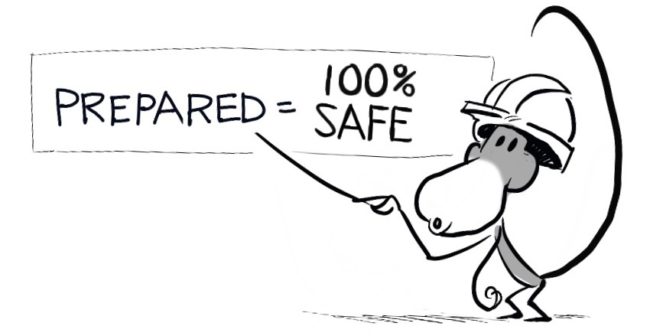
As a therapist who specializes in treating anxiety, I recognized the chattering of my monkey mind. Something is wrong and I should have prevented it! The belief that we can eliminate all uncertainty and guarantee safety and security is the biggest cause of anxiety I see among my clients. But as my experience showed, even a planner like me can’t be prepared for everything. I knew that if continued to feed that monkey mindset I was destined for more chronic worry and stress. When I examined my values, I knew that it is better to live in the present moment and be flexible about the future than it is to lose the present moment trying to control the future.
My healthier mindset has been severely tested. The night of the fire, I lost a lot of things that I loved, and I don’t want to lose any more. But I ran out of the door with two precious resources that no disaster could take away from me; flexibility and resilience. I’ll use and develop them every day for the rest of my life.
As a therapist and author who specializes in stress and anxiety, and has lost my home in the Santa Rosa fire, I am writing this blog to remind myself of the powerful tools I use in my practice with my clients. If It helps others to deal with their own challenges, nothing would please me more.
Dealing with Crisis – Looking for Normal
By Jennifer Shannon, LMFT
It has been three weeks since the wildfires ravished Northern California, and I, along with so many others, lost their homes and everything in it. So many changes! Learning where everything is at my friend’s house where we are staying temporarily. Shopping at new grocery stores, learning which aisle has what stuff. Replacing our burned car with a new one with a new set of buttons to push. Driving in Santa Rosa and suddenly coming upon a entire block that has been burned, leaving charred earth and twisted metal. Looking up at the surrounding hills that the fire devastated. Nothing feels normal anymore.
Least of all my brain. I am a highly organized person, but I really believe that I can relate to people with ADD now. I start a sentence and then can’t remember where I was going with it. Having so few possessions, one would think I could keep track of them, but I have lost my water bottle and needed to get a new one twice in the past four days. I misplace my eyeglasses at least five times a day. The other day I tried to add something to my iPhone calendar, something I have been doing for years, and I could not remember how to do it! I feel emotionally fragile, easily exhausted and overwhelmed.
I do know, as a therapist, that routine and structure are important. So, I have purposely been doing things that I did before. I have returned to my gym, doing my familiar workouts, and this has felt great. I have been attending my regular Feldenkrais class and Doug and I are meditating at least once a day, just as we did before. But the biggest structured routine in my life has been my work, and this week I decided to return to it. The thought of it excited me, but scared me too. Could I be there for my clients? Could I focus? Would I have enough energy for it?
 Walking into my office and seeing my desk, my chairs, my books felt good. The first thing I did was water my plants. Soon it was time for my first session. My client felt awkward talking about her issues, when it was my house that burned down, but soon we eased into the work at hand. Listening attentively, choosing tools to help her with, felt like second nature to me. I could do this! I felt focus, a sense of purpose, and more steady than I had felt since the fire. It was as if the rudder that I could not feel that morning, dropped down, righting and steadying me among the waves of uncertainty.
Walking into my office and seeing my desk, my chairs, my books felt good. The first thing I did was water my plants. Soon it was time for my first session. My client felt awkward talking about her issues, when it was my house that burned down, but soon we eased into the work at hand. Listening attentively, choosing tools to help her with, felt like second nature to me. I could do this! I felt focus, a sense of purpose, and more steady than I had felt since the fire. It was as if the rudder that I could not feel that morning, dropped down, righting and steadying me among the waves of uncertainty.
So, going back to work was finding some normalcy. It does not mean that everything is back to normal. Most things aren’t, and won’t be for a good long time. But for those fifty minutes, I knew what I needed to do, and I could do it. And that felt good.
As a therapist and author who specializes in stress and anxiety, and has lost my home in the Santa Rosa fire, I am writing this blog to remind myself of the powerful tools I use in my practice with my clients. If It helps others to deal with their own challenges, nothing would please me more.
Dealing with Crisis – It’s Your Ride
By Jennifer Shannon, LMFT
Spin is my least favorite workout, but nevertheless I pushed myself out of bed this morning and headed to the Parkpoint Club for Lana’s early morning spin class. Even though spin is hard for me, it delivers the biggest endorphin high of any exercise, and after all I’d been through, I needed it. But today, that high seemed many, many miles away.
Just minutes into the class, my body felt really heavy and I couldn’t catch my breath. Lana called for a hill climb, which meant increasing the gear tension. That by itself was intense, but on top of that Lana shouted out to increase the gears by 3, then down by 1, then up by 3 again. This meant that I had to add and subtract in my head while pushing my body to its limits, and since my home burned down in the fire, my brain function has been compromised.
I made a veiled complaint, disguised as a joke about how the math was too hard for me. Lana, on her infinite wisdom said, to the entire class, “Everyone has been effected by this fire and it takes a toll on the body. The smoke has affected our lungs and the stress has affected our heart rates. Go easy on yourselves and listen to your body. It’s your ride”
Lana was right. I’d been working myself too hard, trying to meet expectations that didn’t apply to me in the moment. My ideas of what I should be able to do were ruining my experience of what I could do. The next time Lana instructed us increase the gear tension, I decreased it. When she said three gears I did two (easier to count to and not as physically challenging). Honoring my own body this way, I felt a growing sense of freedom and ease. Before long, I was actually enjoying spin class.
Afterwards as I left the gym, I began to review my plans for the day, and immediately I felt the tug and pressure of the should and the expectations. But wait, I thought. it’s all my ride, every minute of the day!
THE PICTURE TELLS A STORY
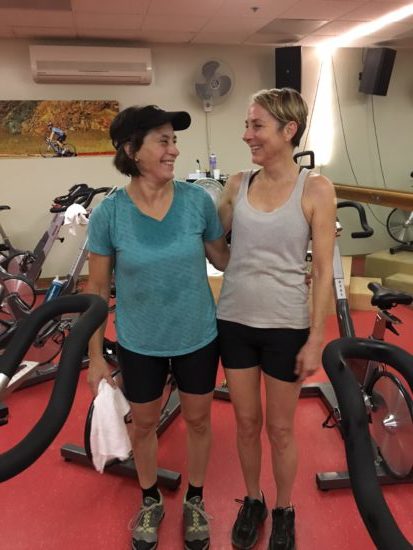
The bike shorts were lent to me by Lana the instructor right before class.
The tank top is something I gave to my daughter a year ago that she gave back to me after the fire.
The shoes are actually what I wore out of the house during the fire.
As a therapist and author who specializes in stress and anxiety, and has lost my home in the Santa Rosa fire, I am writing this blog to remind myself of the powerful tools I use in my practice with my clients. If It helps others to deal with their own challenges, nothing would please me more.
Dealing with Crisis – So who’s the bitch?
By Jennifer Shannon, LMFT with Doug Shannon

Since losing our home in the Tubbs fire, Doug, my husband, and I are together 24/7. Since both of us have taken time off from our jobs, we’ve had a good dose of togetherness. Honestly, right now, I don’t want to be away from him. I’m like a child with separation anxiety whenever we’re apart. But that doesn’t mean I am all sweetness and love to him when we’re together.
This is true especially on the road. Since we lost one car in the fire, we go everywhere together, and when Doug’s at the wheel I’ve found myself telling him when to slow down, where to park, and which way to turn. Yesterday while driving to a post office to pick up our mail, I got so angry at him I called him “a little bitch.” Oh boy! Have you ever seen an angry monkey throwing its poop at an adversary? I was hijacked by my monkey mind, in a fight-flight reaction—emphasis on the fight.
Doug was quiet for a few minutes. Then he said that it had really hurt and that he couldn’t handle name calling. This is a boundary neither of us had ever had to ask the other for, nor had I imagined we’d ever have to. But guess what, instead of apologizing, all I wanted to do was defend and justify myself. While I did have the presence of mind to resist that urge, all I could manage to do was sit there silently, burning with anger and shame. I knew who was being the bitch.
My fault line is needing to feel in control of my surroundings. I have certain ways that I think things should be done, and when something isn’t done my way I can easily feel like I’m losing control. I may point out to others how to do it, or worse, try to take over and do it myself. While I have made progress on working on this part of my personality, in times of stress, like now, I can regress! To help me keep my need for control under control, I made up some rules for myself:
Don’t defend myself
Don’t point things out unless the situation is dangerous
Don’t name call (duh!)
Do breathe into the tightness in my chest and other signs of stress
Do forgive myself for my transgressions
Do let go of control
Having rules to follow in times of chaos is a great start, but I’m human, and I know I’m going to break them sometimes. And that is a great time to practice self-compassion.
As a therapist and author who specializes in stress and anxiety, and has lost my home in the Santa Rosa fire, I am writing this blog to remind myself of the powerful tools I use in my practice with my clients. If It helps others to deal with their own challenges, nothing would please me more.


Recent Comments